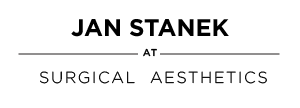Brow Lift Surgery by Jan Stanek at Surgical Aesthetics London
Brows are like curtains of the face. When fully opened the face lightens up and looks bright and cheerful. When closed the face looks gloomy and tired. Ageing leads to descent of brows and gradually the upper eyelid fold becomes more obscured and eyes acquire a tired look. Movement of eyebrows expresses surprise, concentration, anger and sorrow. Those individuals who use their forehead muscles excessively gradually lose their youthful looks by acquiring deep forehead furrows and frown lines just above the nose. These may be the only lines on the face and give the appearance of premature ageing. This is not to say that motionless forehead is an expression of youth.
The position of eyebrows is subject to certain rules and depends on facial proportions. However, it is fairly constant, within few millimetres, in most individuals. Males on the whole have brows lower than females and excessive elevation would lead to a feminising effect.
Until quite recently browlifting was not a popular option for both surgeons and patients. Surgeons did not like the procedure because it was bloody, and results were not good or long lasting. Moreover, there were postoperative problems with hair loss and spreading scars. Patients did not like the procedure because of the length of the scar and the notion of being “scalped”. For the above reasons, browlifting/forehead lifting was unpopular and most patients undergoing face lifting had their foreheads and brows untouched. This resulted in strangely disjointed faces which clearly suggested that something had been done to them. They were half-rejuvenated. Some surgeons tried to reposition the brow by excising skin above the brow; and although it did the job, the patient was left with a scar along the top of the brow which was clearly visible and difficult to disguise.
Brow Lift: A Short History
The browlifting revolution started at the end of 1992 when several surgeons presented work on browlifting using endoscopy, or keyhole surgery. From there on the technique was refined to its present state-of-the art form. To say that endoscopy has revolutionised facial rejuvenation is an understatement. It has enabled surgeons to improve their face-lifting results, and offer browlifting to the young and male balding patients who previously were unable to benefit from surgery. It is fair to say that endoscopic browlifting is here to stay and old “classic” techniques are on the way out except in a few selected cases.
The classic, or bicoronal forehead lift is carried out through an incision in the scalp extending from ear to ear. If the height of forehead is too high, the incision has to be carried out just in front of the hairline to prevent hairline from being shifted back even further. The scalp and forehead are lifted off the bone as far as the eyebrows, and stretched back, with excess of scalp excised. During the operation some muscles of the forehead are weakened or even ablated to reduce frowning and wrinkling of the forehead.
A Modern Day Approach to Brow Lift Surgery
The endoscopic browlift is based on much sounder concept of repositioning, rather than stretching. Only 5 or 6 one centimetre long incisions, placed behind the hairline are needed for the surgery. Through these incisions the scalp is lifted beneath the lining of the bone and lifted as far as the eyebrows, outer corners of the eyes, and as far back as the top of the head. The operation is visualised using an endoscope, which is a camera attached to telescope which transmits pictures onto a television screen. The surgeon operates by watching the screen and not his hands. The essential detail of this surgery is to release the brows from their original position, so that they can be repositioned, weaken the muscles of frowning, and in some cases lift the outer corners of the eyes. The newly repositioned eyebrows are then fixed, usually using miniature screws. These, together with metal clips and sutures are removed a week to 10 days later post-operatively. The position of the eyebrows has to be somewhat overcorrected because there will be some settling for several weeks after surgery.
The result of this operation is a fresher, rejuvenated, and natural look without any evidence of surgery. Together with face lifting it enhances the overall result.
As with all operations there are some risks involved. The endoscopic browlift is the safer of the two procedures. They can be carried out on a day-care or overnight basis, either under local or general anaesthesia, although general anaesthesia is preferable.
The possible problems that can occur after surgery are:
1. Bleeding: very rare with endoscopy
2. Infection: unusual, especially when antibiotics are used to cover both the surgery and the post-operative period.
3. Numbness of the scalp: this occurs in all patients, and resolves in the majority after weeks or months. Pain is not normally a feature of this operation, but has been observed in a small number of patients.
4. Scars: in some individuals they may become thickened, but this is uncommon in the scalp.
5. Hair loss: this was not uncommon in the classic forehead lift, however, it is rare after endoscopic browlift.
6. Overcorrection or under-correction.
7. Injury to the facial nerve: this nerve is responsible for moving brows and frowning. In the majority of cases the function recovers after weeks or months, and permanent injury is uncommon.
Find out more
For more information about brow lift surgery, or to book a consultation with Jan Stanek at Surgical Aesthetics in London, please enquire below.





